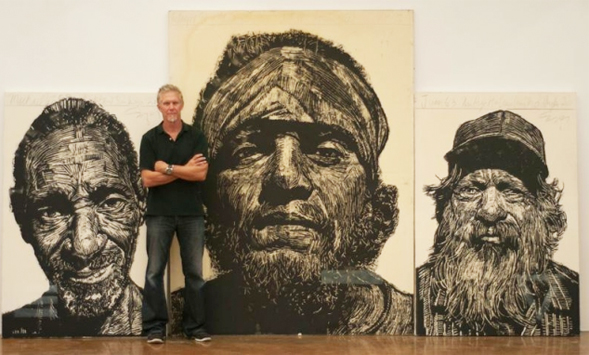Neil Shigley's Invisible People
An exhibition of Shigley's work opens Nov. 1 at the Oceanside Museum of Art.

The portrait of “Michael 67 (Pastor Shelby),” which was featured in the National Portrait Gallery's 2013 Outwin Boochever Portrait Competition, is a block-print image. In portrait work, my focus is to capture the likeness of an individual by using descriptive marks to describe how light hits the forms of the face.
My dream for each portrait is, in some small way, to touch on the human condition. Each portrait starts with a walk around various areas of San Diego, where I talk to people living on the street. I approach them with a great deal of respect. Even though they don’t have a home, they still have a space that is theirs. As an artist I am looking for interesting characters.
When I see someone who intrigues me, I approach them and explain to them that I am an artist and would like to do a portrait of them. Some say yes, some say no. If they agree, I spend some time talking to them about their life, their history, their plans, their dreams, and why they are on the streets.
I take one to two photographs; I don’t try to set the photos up in any way except that they are facing into the light, because I am looking for the most honest portrayal I can get. From the photo I do a number of drawings.
Once I am satisfied with a drawing, I blow it up to the size of the piece of Plexiglas that will be carved, usually about 36 x 48 inches. I place the drawing behind the Plexiglas and begin carving, using a flexible shaft drill. The carving takes six to eight hours per sheet. The carved Plexiglas is then rolled with ink.
I place a piece of paper over it and rub it by hand to transfer the ink on to the paper. When the ink is dry, I soak the paper in water then adhere it with matt medium to canvas that is stretched over a wood panel. When the piece is dry, I trim the excess paper.
At the top of the piece, I hand-write the name and age of the sitter, the place I met him or her, the year, and number of the print, along with my signature. At the bottom of the image, I hand-paint a symbol that is one of many used by drifters in the 1930s to relay information about a place to other drifters who may pass that way later. The symbol I choose relates in some way to the individual portrayed.
Neil Shigley studied painting and printmaking at San Diego State University before graduating with honors from Pasadena’s Art Center College of Design. He currently teaches at SDSU’s College of Art & Design. This column was taken in part from the National Portrait Gallery blog, “facetoface.”
This story is a part of a series "Aztec Voices," featuring personal stories from SDSU faculty, staff and students about their discoveries; academic-related travel; aha! moments; long-term projects finally coming to fruition; or transformational experiences. If you would like to submit a column for "Aztec Voices," please contact SDSU's Marketing and Communications department.



